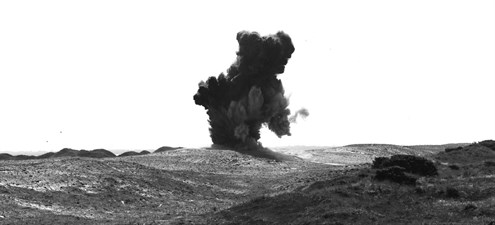Landmine Monitor 2012
Major Findings

Clearance activities in Skallingen Peninsula, Denmark in 2012.
Gloabal Landmine Overview 2011–2012
The Monitor identified one government using antipersonnel mines so far in 2012 – Syria.
- In 2011, Israel, Libya, and Myanmar used antipersonnel mines.
- Use by non-state armed groups was confirmed in six countries – Afghanistan, Colombia, Myanmar, Pakistan, Thailand, and Yemen – up from four countries in the last report.
A total of 4,286 new casualties from landmines and explosive remnants of war were recorded in 2011.
- The 2011 figure is similar to the number of casualties identified in 2009 and 2010, or approximately 11-12 casualties per day. The annual incidence rate is about a third of what it was one decade ago, when there were at least 32 casualties per day.
- Steady decreases in annual casualty rates continued in some of the most mine-affected countries, such as Afghanistan and Cambodia, but these were offset by increases in countries with new or intensified conflicts, such as Libya, Pakistan, Sudan, South Sudan, and Syria.
- Due to incomplete data collection, the actual number of casualties was certainly higher than what was recorded.
Some 59 states and six other areas were confirmed to be affected by landmines. A further 12 states have either suspected or residual mine contamination.
- Guinea-Bissau, Nepal, and Nigeria finished clearing all known mined areas in 2011; clearance was also completed in Abkhazia.
At least 190km2 of mined areas were released through clearance or survey by 37 mine action programs in 2011, destroying more than 325,000 antipersonnel mines and almost 30,000 antivehicle mines.
- Over the past decade, 1,700km2 has been released through clearance or survey; over 3.1 million mines were removed from the ground.
- The largest total clearance of mined areas was achieved by programs in Afghanistan, Cambodia, Croatia, and Sri Lanka, which together accounted for more than 80% of recorded clearance.
- An additional 233km2 of former battle area was reportedly cleared in 2011, destroying in the process more than 830,000 items of unexploded or abandoned ordnance, as well as 55km2 of cluster-munition-contaminated areas, with the destruction of more than 52,000 unexploded submunitions.
Setbacks in the availability and accessibility of assistance and services for survivors occurred in at least 12 countries in 2011, most as a result of declining international assistance and new or intensified conflicts.
- Direct international support for victim assistance programs through international mine action funding declined by US$13.6 million, an almost 30% decrease from 2010.
- The 2011 annual total of $30 million is the lowest annual total for victim assistance since the Monitor began reporting. There were no indications that national funding or international development sources had filled the gaps created.
Donors and affected states contributed approximately US$662 million in international and national support for mine action in 2011, approximately $25 million more than in 2010, the largest combined total ever.
- In 2011, 42 donors contributed US$467 million in international support for mine action in 57 affected states and areas, a slight decrease of $13 million (3%) from 2010. This is the sixth consecutive year that international contributions totaled over $400 million per year.
- Thirty affected states provided US$195 million, 29% of global funding, in national support for mine action towards their own mine action programs, an increase of $38 million compared with 2010.
The production of antipersonnel mines has dwindled to a dozen states; there have been no recorded transfers of the weapon in recent years.
- Active production of antipersonnel mines may be ongoing in as few as four countries: India, Myanmar, Pakistan, and South Korea.
- Another eight countries reserve the right to produce antipersonnel mines: China, Cuba, Iran, North Korea, Russia, Singapore, the US, and Vietnam.
Overview of Mine Ban Treaty Implementation and Compliance
- Three countries have joined the Mine Ban Treaty since July 2011: South Sudan (July 2011), Finland (January 2012), and Somalia (April 2012). With the additions of Somalia and South Sudan, all states in Sub-Saharan Africa are now States Parties, thus completing universalization in the sub-continent.
- Since September 2011, there have been new allegations of mine use by government forces in States Parties Sudan and Yemen that warrant ongoing attention, investigation, and resolution.
- A total of 19 States Parties have officially reported completion of their obligation to clear all known or suspected areas containing antipersonnel mines in territory under their jurisdiction or control. Of the other 45 States Parties that the Monitor believes have outstanding treaty obligations, 27 States Parties have been granted at least one extension period.
- 87 States Parties have officially declared completion of stockpile destruction, collectively destroying more than 46 million stockpiled antipersonnel mines. Turkey, which had missed its deadline in 2008, completed destruction in 2011. Three States Parties remain in violation of the treaty after having failed to complete the destruction of their stockpiles by their four-year deadline: Belarus, Greece, and Ukraine.
- Since the Mine Ban Treaty went into effect, most States Parties with significant numbers of survivors strengthened ownership for victim assistance through better coordination, planning, and understanding survivors’ needs and challenges.

